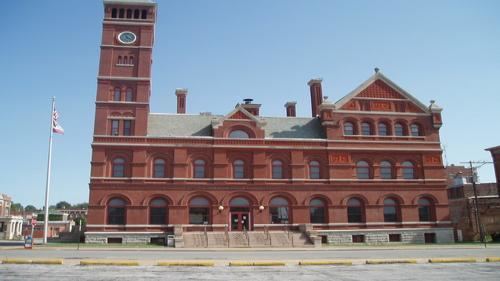Founded 1836 Area 1,396 km² | Congressional district 2nd Website www.leecounty.org Population 35,682 (2013) Unemployment rate 5.7% (Apr 2015) | |
 | ||
Cities Points of interest Rand Park, Rodeo Park, Old Madison Fort, Victory Park, Sheaffer Pen Museum | ||
Lee County, Iowa, was established in 1836. As of the 2010 census, the population was 35,862. It has two county seats — Fort Madison and Keokuk. Lee County is part of the Fort Madison–Keokuk, IA-IL-MO Micropolitan Statistical Area.
Contents
- Map of Lee County IA USA
- History
- Name
- Geography
- Major highways
- Adjacent counties
- 2000 census
- 2010 census
- Census designated place
- Other unincorporated communities
- Population ranking
- Notable people
- References
Map of Lee County, IA, USA
History
Fort Madison dates to the War of 1812. Lee County was the location of the Half-Breed Tract, established by treaty in 1824. Allocations of land were made to American Indian descendants of European fathers and Indian mothers at this tract. Originally the land was to be held in common. Some who had an allocation lived in cities, where they hoped to make better livings.
Lee County as a named entity was formed on December 7, 1836, under the jurisdiction of Wisconsin Territory. It would become a part of Iowa Territory when it was formed on July 4, 1838. Large-scale European-American settlement in the area began in 1839, after Congress allowed owners to sell land individually. Members of the Church of Christ (Latter Day Saints) fled persecutions in Missouri to settle in Illinois and Iowa. Nauvoo, across the border in Hancock County, Illinois, became the main center of Latter-day Saints settlement, but there was also a Latter Day Saints stake organized in Lee County under the direction of John Smith, the uncle of Joseph Smith, land that was sold to them by Isaac Galland in 1839.
Lee has two county seats — Fort Madison and Keokuk. The latter was established in 1847 when disagreements led to a second court jurisdiction.
Lee County's population grew to about 19,000 in 1850, the first US census, to 37,000 per the 3rd census in 1870, peaking at 44,000 people in 1960. It has continuously decreased since and as of 2010, 35,862 people lived there, comparable to the years between 1860-1870.
Name
There is no agreement about the derivation of the name "Lee." It has been variously proposed that the county was named for Marsh, Delevan & Lee, of Albany, New York, and the 'New York Land Company', who owned extensive interests in the Half-Breed Tract in the 1830s; Robert E. Lee, who surveyed the Des Moines Rapids; or Albert Lea, who helped explore the interior of Iowa.
Geography
According to the U.S. Census Bureau, the county has a total area of 539 square miles (1,400 km2), of which 518 square miles (1,340 km2) is land and 21 square miles (54 km2) (4.0%) is water. The lowest point in the state of Iowa is located on the Mississippi River in Keokuk in Lee County, where it flows out of Iowa and into Missouri and Illinois.
Major highways
Adjacent counties
Lee County is surrounded by Henry County to the north, Des Moines County to the northeast, Henderson County, Illinois, across the river east, Hancock County, Illinois to the southeast, Clark County, Missouri in the southwest and Van Buren County, Iowa in the west.
2000 census
As of the census of 2000, there were 38,052 people, 15,161 households, and 10,248 families residing in the county. The population density was 74 people per square mile (28/km²). There were 16,612 housing units at an average density of 32 per square mile (12/km²). The racial makeup of the county was 94.24% White, 2.80% Black or African American, 0.26% Native American, 0.39% Asian, 0.06% Pacific Islander, 1.03% from other races, and 1.21% from two or more races. 2.37% of the population were Hispanic or Latino of any race.
There were 15,161 households out of which 30.40% had children under the age of 18 living with them, 53.70% were married couples living together, 10.30% had a female householder with no husband present, and 32.40% were non-families. 28.30% of all households were made up of individuals and 13.50% had someone living alone who was 65 years of age or older. The average household size was 2.41 and the average family size was 2.93.
In the county, the population was spread out with 24.40% under the age of 18, 7.80% from 18 to 24, 26.70% from 25 to 44, 24.60% from 45 to 64, and 16.50% who were 65 years of age or older. The median age was 40 years. For every 100 females there were 97.90 males. For every 100 females age 18 and over, there were 96.40 males.
The median income for a household in the county was $36,193, and the median income for a family was $42,658. Males had a median income of $32,286 versus $21,821 for females. The per capita income for the county was $18,430. About 7.10% of families and 9.70% of the population were below the poverty line, including 12.60% of those under age 18 and 9.60% of those age 65 or over.
2010 census
The 2010 census recorded a population of 35,862 with a population density of 69.3133/sq mi (26.7620/km2). There were 16,205 housing units, of which only 14,610 were occupied.
Census-designated place
Other unincorporated communities
Population ranking
The population ranking of the following table is based on the 2010 census of Lee County.
† county seat
